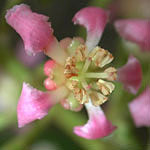
Andersoniella C. Davis & Amorim, Harvard Pap. Botany 25: 52. 2020a, non Andersoniella
K. J. F. Schmitz, 1897 (Rhodophyta).—Type: A. spruceana (Nied.) C. Davis & Amorim.
Shrubs or small trees; stipules intrapetiolar, 2/3 to completely connate, persistent on petiole; leaves bearing glands impressed in abaxial surface of lamina. Inflorescence terminal (rarely axillary), often pendent, an unbranched raceme of few-flowered cincinni or dichasia or a pseudoraceme of single flowers [1-flowered cincinni]; floriferous peduncles developed; bracteoles persistent, borne at or below apex of peduncle, one or more bearing 1 large terminal or abaxial gland. Sepals leaving outermost petal exposed in enlarging bud, all biglandular with adjacent glands sometimes partially connate (in A. marcelae eglandular) or 2 adjacent sepals bearing 1 gland each, the glands borne on or below free part of sepals; corolla bilaterally symmetrical, the posterior petal slightly to strongly differentiated from the lateral 4; petals pink or white to pink, entire or minutely denticulate, dorsally rounded, smooth or the claw slightly carinate, glabrous; androecium radially symmetrical; stamens glabrous; filaments distinct or slightly connate at base, longer opposite sepals than opposite petals; anthers alike, the outer locules bearing dark longitudinal wings; pollen 3 (4)-colporate, the colpi distally bifurcate in some spp.; receptacle glabrous; gynoecium radially symmetrical; ovary with the carpels 2–3, connate along a narrow to broad adaxial axis or face; styles 3, slender and subulate with minute stigmas. Cocci smooth and rounded, the ventral areole broad and flat. Chromosome number: n = 6 (A. hammelii; W. R. Anderson, 1993a); photo.
Three species, one in Costa Rica, the other two in Amazonian South America [map]. All species grow along rivers in wet forests or in sandy open places near rivers; the cocci are probably dispersed by water. — Regional key to genera: Central America.
Andersoniodoxa shares with Lophanthera prominent longitudinal wings on the outer locules of the anthers, found nowhere else in the Galphimia clade (the vesicles on the anthers of Verrucularia may be homologous with those wings). Similar anther wings are found in the genera Acmanthera and Pterandra of the Acmanthera clade, presumably the result of parallel evolution. The three species of Andersoniodoxa were formerly included in Lophanthera. Re-examination of the Galphimia clade (Davis et al., 2020a) showed them as distinct, and they were moved into a separate genus.
References: Davis, C. C., L. C. Marinho, and A. A. Amorím, 2020a (as Andersoniella); Davis, C. C., L. C. Marinho, and A. A. Amorím, 2020b (Andersoniodoxa, replacement name).
Etymology: The names Andersoniodoxa and Andersoniella honor the American botanist William Russell Anderson (1942–2013), student of the Malpighiaceae.
Photos: chromosomes; A. hammelii
Drawing: A. hammelii